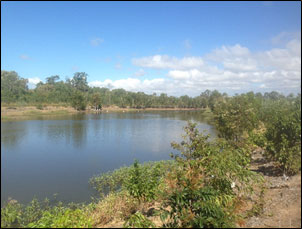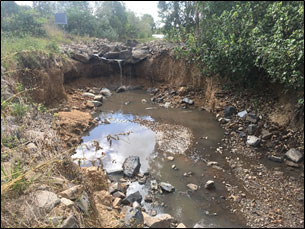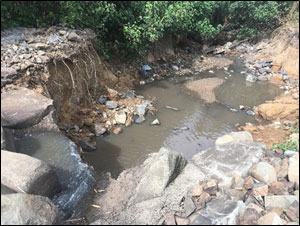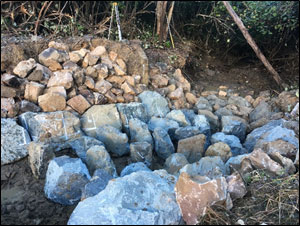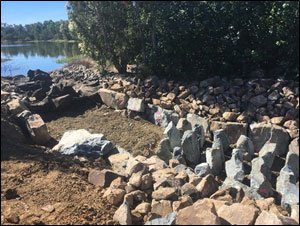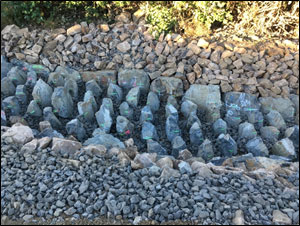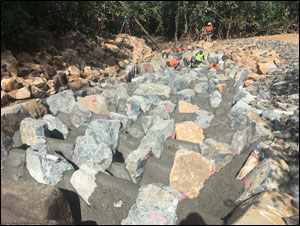Bakers Creek Treatment Train Wetlands Fishway Construction
Sep 19, 2019
In June 2019, fish passage from the Bakers Creek estuary into the Bakers Creek treatment train wetlands was rehabilitated through the installation of a rock-ramp fishway. The treatment train wetlands located south of Mackay were constructed in 2014, to serve as a series of sediment and nutrient retention basins, treating sugar cane runoff and improving…
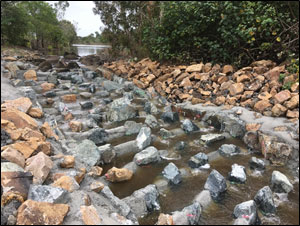
In June 2019, fish passage from the Bakers Creek estuary into the Bakers Creek treatment train wetlands was rehabilitated through the installation of a rock-ramp fishway. The treatment train wetlands located south of Mackay were constructed in 2014, to serve as a series of sediment and nutrient retention basins, treating sugar cane runoff and improving water quality before entering the estuary. The spillway at the downstream limit of the treatment train wetlands unfortunately washed away and became a significant scour hole during extreme flow turbulence caused by tropical cyclone Debbie in 2017.
Figure 1. Left; the Bakers Creek treatment train wetlands, and right; large scour hole resulting from significant stream flows during tropical cyclone Debbie in the 2017 wet season.
Whilst primarily functioning as a water quality treatment train the extensive wetlands also provide abundant habitat for commercially and recreationally important fish species such as juvenile barramundi and a multitude of other native fish community species. Unfortunately, the extensive damage to the spillway following the cyclone resulted in effectively no fish passage for fish to enter the wetlands from the estuary. In order to provide aquatic connectivity between the wetland and estuarine habitats, Reef Catchments NRM group provided funding for Catchment Solutions to construct a rock-ramp fishway at the site.
Due to the significant height of the barrier (3.8m surface headloss) and the working space available at the site, the rock-ramp fishway was required to incorporate innovative design features to ensure sufficient flow dissipation and resting zones for fish. The fishway was constructed with 38 ridges and pools, with 100mm drops between each pool and 1m spacing between ridge rocks. Due to the relatively short spacing between ridge rocks, all ridge slots along the entire left side (facing upstream) were ‘blanked out’ with concrete, to create still water in every fishway pool along the entire left-hand side. This provides sufficient resting zones throughout the fish ladder for migrating juvenile fish ascending the structure to reach the nursery wetlands upstream. This fishway is now the highest rock-ramp fishway in Queensland, and possibly in Australia.
Monitoring of the structure during flow events of the 2019/2020 wet season are anticipated to yield extremely positive results in terms of utilisation by a range of species and size classes. The monitoring results obtained will be critical in validating the innovative design utilised at this barrier site. Monitoring results will likely lead to the uptake of this design at similar barriers throughout the state and across the country, where cost-effective rock-ramp fishways are often overlooked as a suitable fish passage rehabilitation option.
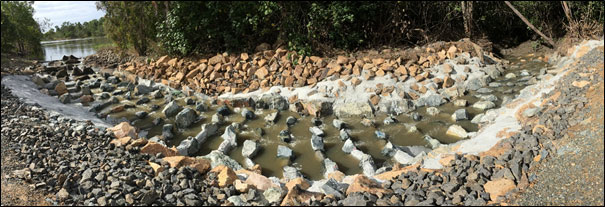
Figure 2. Top left; Scour hole at spillway before fishway construction, top right; commencement of lower ridge construction, mid left; construction near completion, showing upper ridges in place, mid right; completed fishway prior to concreting, lower left; concreting fishway in place, to precise ridge control heights, lower right; fishway during first flow event following construction and bottom; panoramic image of fishway during first flow following construction.
